Mayan Art and Architecture
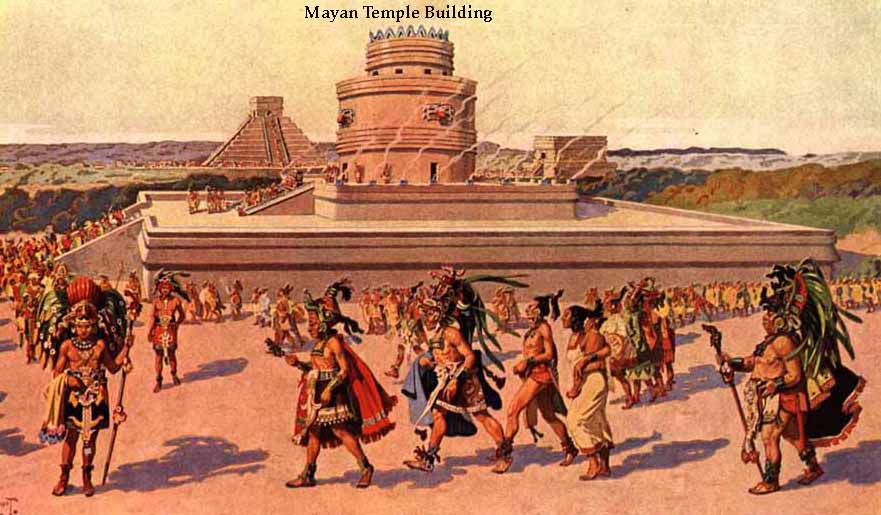
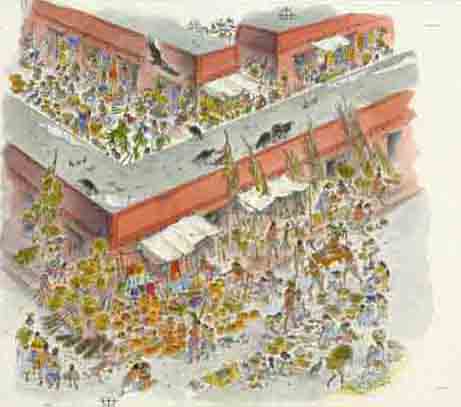
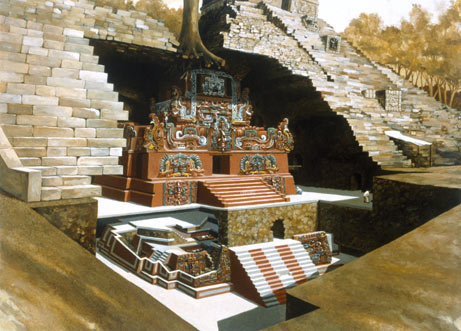
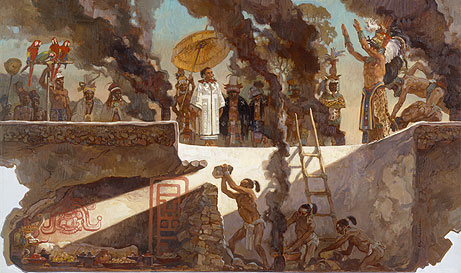
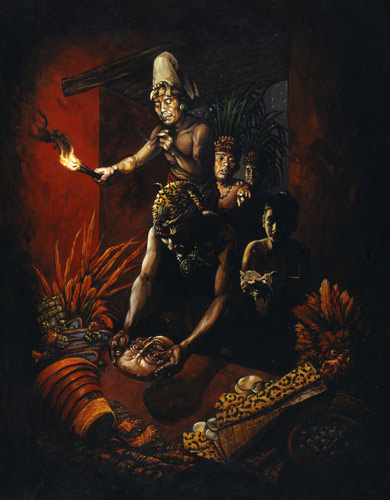
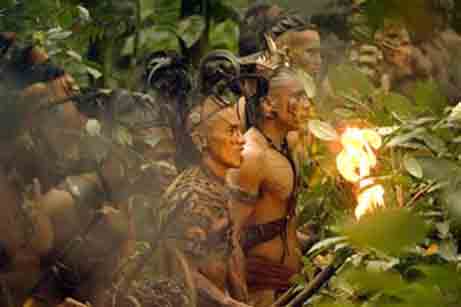
As unique and spectacular as any Greek or Roman architecture, Maya architecture spans many thousands of years; yet, often the most dramatic and easily recognizable as Maya are the fantastic stepped pyramids from the Terminal Pre-classic period and beyond. Being based on the general Mesoamerican architectural traditions these pyramids relied on intricate carved stone in order to create a stair-step design. Each pyramid was dedicated to a deity whose shrine sat at its peak. During this "height" of Maya culture, the centers of their religious, commercial and bureaucratic power grew into incredible cities, including Chichen Itza, Tikal, and Uxmal. Through observation of the numerous consistent elements and stylistic distinctions, remnants of Maya architecture have become an important key to understanding the evolution of their ancient civilization.
With the decipherment of the Maya script it was discovered that the Maya were one of the few civilizations where artists attached their name to their work. The art of the Maya has been called the richest of the New World because of the great complexity of patterns and variety of media expressions. Limestone structures, faced with lime stucco, were the hallmark of ancient Maya architecture. Maya buildings were adorned with carved friezes and roof combs in stone and stucco. With large quantities of limestone and flint available, plaster and cement were easily produced. This allowed the Mayans to build impressive temples, with stepped pyramids. On the summits were thatched- roof temples. Evidence show that the early Maya architects were using the corbel vault principle, which is arch like structures with sides that extend inward until they meet at the top.
Another matchless feature of the Mayans was the use of colorful murals. It is also noted that most of the Maya cities were built by being divided into quaters by two avenues which cross-cut each other at right angles. Roofs were flat and made with cedar beams overlaid with mortar. The walls were plastered and painted with great gods and other mythological features.
Tombs were often encased within or beneath Mayan structures. Frequently new temples were built over existing structures. The Mayans also expressed themselves artistically. Their ceramics were made in a large variety of forms and decorated with complex scenes. The Mayans also designed works of art from flint, bone and shell, along with making decorated cotton textiles. Even metal was used for ceremonial purposes. Items made with metal include necklaces, bracelets and headresses.
It is evident that all of the structures built by the ancient Mayans were built in honor of the gods. Compounds were built with large open areas, from which all the citizens could view the religious ceremonies taking place on the platforms elevated above the city. On the other hand, the construction of the Castillo, seems to relate to the ancient Maya's obsession with the calendar. For example, each stairway in the temple has 91 steps, making a total of 364 steps in the four staircases, which, counting the platform at the top of the pyramid, equals the total number of days in the solar year. Even more so, each side of the pyramid has nine stepped terraces divided by a stairway, for a total of eighteen sections on each side, consequently, the number of months in the Mayan calendar. A honeycombed roofcomb towered above many structures, providing a base for painted plaster that was the Maya equivalent of the billboard. In addition to temples, most Maya sites had multi-roomed structures that probably served as royal palaces as well as centers for government affairs.
Historically significant events, such as accessions, the capture or sacrifice of royal victims and the completion of the twenty year katun cycle, were recorded on stone stelae and tablets. Without metal tools, beasts of burden, or even the wheel the Mayans were able to construct vast cities across a huge jungle landscape with an amazing degree of architectural perfection and variety. They were noted as well for elaborate and highly decorated ceremonial architecture, including temple-pyramids, palaces and observatories, all built without metal tools.
As Maya cities spread throughout the varied geography of Mesoamerica, site planning appears to have been minimal. Maya architecture tended to integrate a great degree of natural features, and their cities were built somewhat haphazardly as dictated by the topography of each independent location. For instance, some cities on the flat limestone plains of the northern Yucatan grew into great sprawling municipalities, while others built in the hills of Usumacinta utilized the natural loft of the topography to raise their towers and temples to impressive heights. However, some semblance of order, as required by any large city, still prevailed.
Classic Era Maya urban design could easily be described as the division of space by great monuments and causeways. Open public plazas were the gathering places for people and the focus of urban design, while interior space was entirely secondary. Only in the Late Post-Classic era did the great Maya cities develop into more fortress-like defensive structures that lacked, for the most part, the large and numerous plazas of the Classic.
At the onset of large-scale construction during the Classic Era, a predetermined axis was typically established in a cardinal direction. Depending on the location of natural resources such as fresh-water wells, or cenotes, the city grew by using sacbeob (causeways) to connect great plazas with the numerous platforms that created the sub-structure for nearly all Maya buildings. As more structures were added and existing structures re-built or remodeled, the great Maya cities seemed to take on an almost random identity that contrasted sharply with other great Mesoamerican cities such as Teotihuacan and its rigid grid-like construction.
At the heart of the Maya city were large plazas surrounded by the most important governmental and religious buildings, such as the royal acropolis, great pyramid temples and occasionally ball-courts. Though city layouts evolved as nature dictated, careful attention was placed on the directional orientation of temples and observatories so that they were constructed in accordance with Maya interpretation of the orbits of the heavenly bodies. Immediately outside of this ritual center were the structures of lesser nobles, smaller temples, and individual shrines; the less sacred and less important structures had a greater degree of privacy. Outside of the constantly evolving urban core were the less permanent and more modest homes of the common people.
A surprising aspect of the great Maya structures is their lack of many advanced technologies that would seem to be necessary for such constructions. Lacking metal tools, pulleys and maybe even the wheel, Maya architecture required one thing in abundance: manpower. Yet, beyond this enormous requirement, the remaining materials seem to have been readily available. All stone for Maya structures appears to have been taken from local quarries. They most often utilized limestone, which remained pliable enough to be worked with stone tools while being quarried, and only hardened once removed from its bed. In addition to the structural use of limestone, much of their mortar consisted of crushed, burnt, and mixed limestone that mimicked the properties of cement and was used just as widely for stucco finishing as it was for mortar. However, later improvements in quarrying techniques reduced the necessity for this limestone-stucco as their stones began to fit quite perfectly, yet it remained a crucial element in some post and lintel roofs. In the case of the common Maya houses, wooden poles, adobe, and thatch were the primary materials; however, instances of what appear to be common houses of limestone have been discovered as well. Also notable throughout Mayan architecture is the false arch, whose limitations kept their structures generally weighty rather than airy.
Ceremonial platforms were commonly limestone platforms of typically less than four meters in height where public ceremonies and religious rites were performed. Constructed in the fashion of a typical foundation platform, these were often accented by carved figures, altars and perhaps tzompantli, a stake used to display the heads of victims or defeated Mesoamerican ballgame opponents.
Palaces were large and often highly decorated, and usually sat close to the center of a city and housed the population's elite. Any exceedingly large royal palace, or one consisting of many chambers on different levels might be referred to as an acropolis. However, often these were one-story and consisted of many small chambers and typically at least one interior courtyard; these structures appear to take into account the needed functionality required of a residence, as well as the decoration required for their inhabitants stature.
E-groups are a classification given by Mayanists to certain structure complexes attested in quite a few Maya sites of the central and southern lowlands - Petén region. Complexes of this type consist of a stepped pyramid main structure, which appears without fail on the western side of a quadrilateral plaza or platform. It has been theorized that these E-groups are observatories due to the precise positioning of the sun through the small temples when viewed from the pyramid during the solstices and equinoxes. Other ideas seem to stem from the possible creation story told by the relief and artwork that adorns these structures.
Pyramids and Temples Often the most important religious temples sat atop the towering Maya pyramids, presumably as the closest place to the heavens. While recent discoveries point toward the extensive use of pyramids as tombs, the temples themselves seem to rarely, if ever, contain burials. Residing atop the pyramids, some of over two-hundred feet, such as that at El Mirador, the temples were impressive and decorated structures themselves. Commonly topped with a roof comb, or superficial grandiose wall, these temples might have served as a type of propaganda. As they were often the only structure in a Maya city to exceed the height of the surrounding jungle, the roof combs atop the temples were often carved with representations of rulers that could be seen from vast distances.
Observatories The Maya were keen astronomers and had mapped out the phases of celestial objects, especially the Moon and Venus. Many temples have doorways and other features aligning to celestial events. Round temples, often dedicated to Kukulcan, are perhaps those most often described as "observatories" by modern ruin tour-guides, but there is no evidence that they were so used exclusively, and temple pyramids of other shapes may well have been used for observation as well.
Ball Courts As an integral aspect of the Mesoamerican lifestyle, the courts for their ritual ball-game were constructed throughout the Maya realm and often on a grand scale. Enclosed on two sides by stepped ramps that led to ceremonial platforms or small temples, the ball court itself was of a capital "I" shape and could be found in all but the smallest of Maya cities.
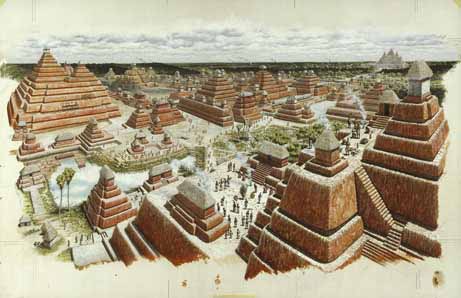
Pyramids of Mexico
The Maya were resourceful in harnessing energy, creating amazingly sophisticated works of art and engineering and sustaining a civilization for approximately 1,500 years. It has been shown that the Maya had attributes of the supernatural, and were masters of their environment. Their secret wisdom remains unknown, some people attributing it to extraterrestrials races, whose space ships are seen to this very day in Central and South America.
As with ancient Egyptian Pharaohs, Mayan rulers filled vast cities with sky high pyramids, ornate and lavish palaces personifying the power of the great kings and their connections to the gods, and astronomical observatories which helped them created their calendars and plan their lives.
The cause of the Mayan collapse came over decades with no one quite sure what happened. There is no one single explanation for this implosion, but some scholars seem to believe that environmental catastropy lead to a full blown meltdown - lack of food and polluted water which produced malnutrition and disease.
As with all civilizations, we discover that their Gods - like those some people worship today our Gods - did not help - as they do not exist - only our own consciousness to guide us in the wastelands of realities.
Mayan archaeology is coming into it's Golden Age with the help of satellite imagery and photography. There are innumerable Mayan cities, temples, and settlements still to be discovered. We have learned that the Maya were an innovative, creative, and majestic people with their own particular taste for violence. The allure of the Maya is coming to the fore. Like the mystique of Egypt, people are drawn to the land of the Maya, each year. There is something they are guided to find, perhaps linked to major planetary grid points that awaken consciousness.
Could other attractions to the land of the Maya include:
- Mayan architecture with its serene palaces and temples
- the intricacies of hieroglyphs and art in a complex writing system
- the astounded comprehension of astronomy and mathematics with a concept of zero unparalleled in antiquity
- is it simply because these remarkable people carved magnificent cities, not just villages and towns, right out of some of the most inhospitable landscape in the entire world? In the rain forest between Honduras and the Yucatan, there are literally thousands of Maya sites that remain untouched. In Palanquealone there are approximately 1,550 buildings that lie unexcavated with endless archaeological treasures yet to be found.
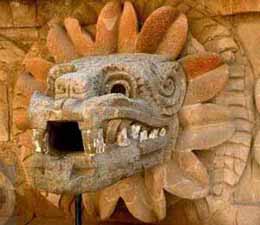
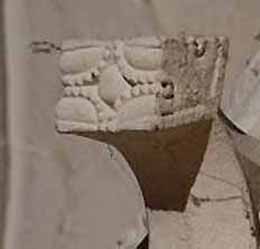
Rosslyn Chapel - Cymatics - Music of the Cubes - Da Vinci Code
Maya Art
Maya art is considered by many to be the most sophisticated and beautiful of the ancient New World. The distinct style of Maya art that developed during the Preclassic period (1500 B.C. to 250 A.D.) has influences from the Olmec civilization. Other Mesoamerican civilizations, including Teotihuacan and the Toltecs, affected Maya art, which reached its zenith during the civilization's Classic period (c. 200 to 900 AD). The Maya are well known for their use of jade, obsidian and stucco.
Many pieces of Maya art are spiritual in nature, designed to appease or curry the favor of the gods. Most Maya art that survives today is in the form of funerary and ritual objects. The Maya did not have metal tools or potter's wheels, however they managed to create highly detailed and beautiful pieces of art. Most Maya art depicts gods, great rulers, legendary heroes, religious scenes and, occasionally, daily life. The focus of Maya art pieces is on human figures (whether gods or mortals). Animals and stylized designs were used as decoration on pottery and other objects. The Maya script, which could be considered an art form itself, is featured on most statues and carvings. Maya art takes many forms, from tiny pieces of carved obsidian to gigantic pyramids and stelae. The dominance of the Maya religion can be seen through all of these art forms; most objects have a spiritual or religious purpose.
The art of the Maya, as with every civilization, is a reflection of their lifestyle and culture. The art was composed of delineation and painting upon paper and plaster, carvings in wood and stone, clay and stucco models, and terra cotta figurines from molds. The technical process of metal working was also highly developed but as the resources were scarce, they only created ornaments in this media. Many of the great programs of Maya art, inscriptions, and architecture were commissioned by Mayan kings to memorialize themselves and ensure their place in history. The prevailing subject of their art is not anonymous priests and unnamed gods but rather men and women of power that serve to recreate the history of the people. The works are a reflection of the society and its interaction with surrounding people.
One of the greatest shows of Mayan artistic ability and culture is the hieroglyphic stairway located at Copan. The stairway is an iconographical complex composed of statues, figures, and ramps in addition to the central stairway which together port ray many elements of Mayan society. An alter is present as well as many pictorial references of sacrifice and their gods. More importantly than all the imagery captured with in this monument, however, is the history of the royal descent depicted in the heiroglyphs and various statues. The figurine of a seated captive is also representative of Mayan society as it depicts someone in the process of a bloodletting ceremony, which included the accession to kingship. This figure is of high rank as depicted by his expensive earrings and intricately woven hip cloth. The rope collar which would usually mark this man as a captive, reveals that he is involved in a bloodletting rite. His genitals are exposed as he is just about to draw blood for the ceremony.
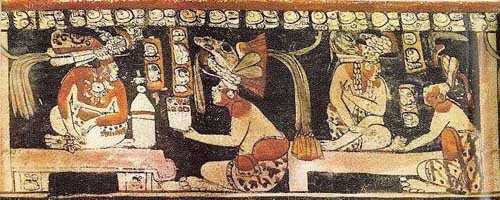
One of the most common themes painted on Maya vases is the royal audience. The ahau, seated characteristically with legs folded, receives visitors. At times the names of the ahau and his visitors are given in glyphs. Most interesting are the details: clothing styles and decorative patterning, face painting, masks worn, gestures made and so forth. Many vases show vases as well as indicate the style of interior decor with its curtains, pillows, and thrones. Hats were of crucial importance to Maya social identity. Often the ahau receiving visitors wears a conical turban hat with a large flower in front of it and quetzal feathers behind; sometimes a hummingbird or fish is attached to the front of that large flower.
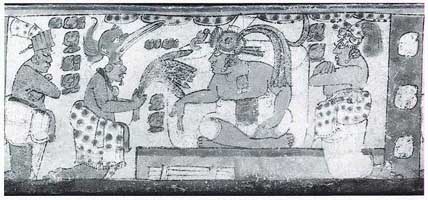
A presentation of quetzal feathers
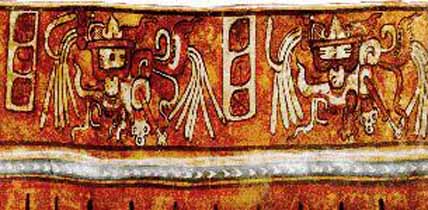
The elements on the head of this dragon are supposedly instruments of self-sacrifice They are found at the base of the supernatural tree displayed as a "cross" on Palenque temples.
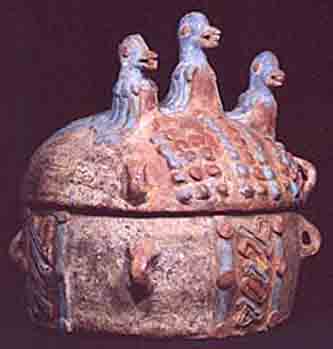
Many examples of Maya pottery survive today. Along with clay vessels, the Maya created many earthenware figures of humans and animals. Several examples of the Teotihuacan fresco technique of applying paint to a wet clay surface have been found at Maya sites, showing the influence that civilization had on Maya art. Most pieces of pottery were decorated with images of humans, animals , or mythological creatures. Many highly detailed clay figurines were made by the Maya, portraying humans and gods. These were made with molds and by hand. Many of these figures were buried with rulers, which is how they survived to the current day.
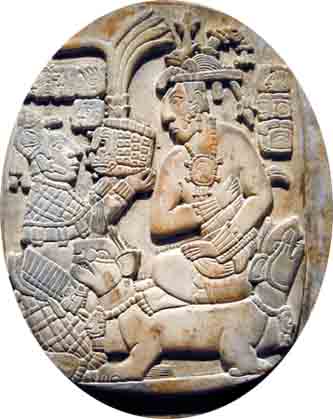
The Maya created a great number of scupltures, many of which can be seen at Maya sites and museums. A common form of Maya sculpture was the stele. These were large stone slabs covered with carvings. Many depict the rulers of the cities they were located in, and others show gods. The stelae almost always contained hieroglyphs, which have been critical to determining the significance and history of Maya sites. Other stone carvings include figurines, similar to the earthenware ones described earlier, and stone lintels which show scenes of blood sacrifice. The Maya used a great deal of jade in their art. Many stone carvings had jade inlays, and there were also ritual objects created from jade. It is remarkable that the Maya, who had no metal tools, created such intricate and beautiful objects from jade, a very hard and dense material. An excellent example is the death mask of Lord Pacal, ruler of Palenque. A life-size mask created for his corpse had "skin" made from jade and "eyes" made from mother-of-pearl and obsidian.
Due to the humid climate of Central America few Maya paintings have survived to the present day. Some murals have been discovered at Bonampak. The paintings at Bonampak were preserved when a layer of calcium carbonate covered the paintings, preventing moisture from destroying them. The murals, which date from 790, show scenes of nobility, battle, and sacrifice. At San Bartolo, murals were discovered in 2001. These paintings date from 100 A.D., and are the some of the oldest Maya paintings discovered. These paintings, which depict the Corn god myth, made scholars realize that the myth was older than previously believed.
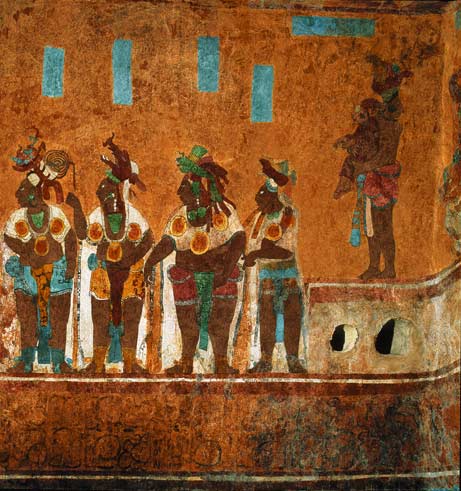
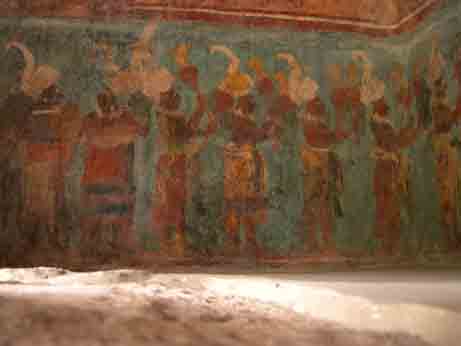
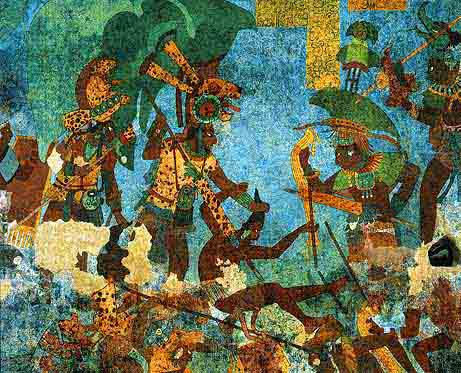
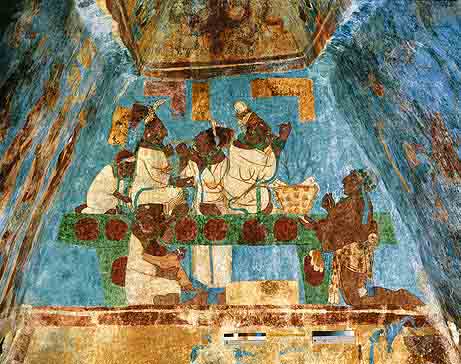
National Geographic